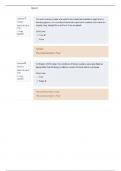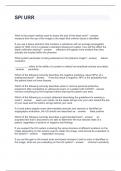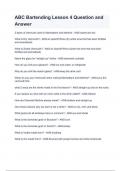Table of Contents
1. Inflation ..................................................................................................................... 2
1.1. What is inflation? .......................................................................................................... 2
1.2. Measures of inflation..................................................................................................... 2
1.2.1. Consumer price index .................................................................................................................... 2
1.2.2. Producer price index ...................................................................................................................... 3
1.2.3. GDP deflator................................................................................................................................... 3
1.3. Why is inflation important ............................................................................................. 3
1.4. Types of inflation ........................................................................................................... 3
1.5. Philips curve .................................................................................................................. 5
1.6. Central bank independence ........................................................................................... 7
1.7. How to lower inflation – contractionary monetary policy (W17) .................................... 8
1.8. Sacrifice ratio................................................................................................................. 8
1.9. Theory of rational expectations ..................................................................................... 8
1.10. Target of monetary policy & Taylor rule......................................................................... 8
2. Demand Side Policies ................................................................................................. 9
2.1. Monetary policy ............................................................................................................ 9
2.2. Fiscal policy ..................................................................................................................11
2.3. Monetary versus fiscal policy ........................................................................................13
2.4. Possible problems with demand side policies ...............................................................14
3. Supply Side Policies .................................................................................................. 14
3.1. New Keynesian aggregate supply curve ........................................................................14
3.2. Supply side policies and sustainable growth .................................................................15
3.3. Types of supply side policies .........................................................................................15
4. Open Economy ......................................................................................................... 17
4.1. Closed and open economies .........................................................................................17
4.2. Balance of payments ....................................................................................................17
4.3. Exchange rates .............................................................................................................19
4.4. Loanable fund market and forex market .......................................................................20
4.5. Trilemma / Impossible trinity .......................................................................................25
,1. Inflation
1.1. What is inflation?
• Inflation – The percentage increase in the price level from the previous period.
• Zero inflation – A constant price level from year to year.
• Deflation – The general price level is decreasing.
• Rising inflation – Inflation is increasing.
• Disinflation – Inflation is falling.
• Hyperinflation – An extremely high rate of inflation.
• Why is inflation bad?
o For people on fixed nominal income (e.g. pensioners, public servants), higher inflation
means lower real value of income.
o Inflation reduces the real value of debt - good for borrowers for loans on nominal
interest rate (e.g. private, government) and bad for creditors.
o High rate of inflation makes the economy less efficient:
§ High inflation often volatile implies uncertainty
§ It is hard for producers to distinguish among changes in relative prices and
inflation
§ Menu costs as firms have to update their prices more frequently.
• Why is deflation bad?
o Deflation could have even more dramatic consequences than high inflation.
o When prices are falling, households will postpone consumption (particularly of
durables) because they expect goods will be cheaper in the future.
o This is similar to a negative shock to aggregate demand.
o Deflation increases the real debt burden, which may lead households to cut
consumption to return to their target wealth.
1.2. Measures of inflation
• Inflation is measured by calculating the change in various price indices. The main measures of
inflation are Consumer price index (CPI), Producer price index (PPI), and GDP deflator.
1.2.1. Consumer price index
• CPI measures the overall cost of the goods and services of a basket of goods that a typical
consumer would buy.
o The percentage change in the CPI over a period of time measures the inflation rate,
in that period.
o Hence, it is used for central bank’s inflation target and indexing, for example, pensions
and wages. The UK however, uses the CPIH, which also includes housing costs.
, 1.2.2. Producer price index
• The PPI is based on the price of several important raw materials bought by firms. Therefore,
it measures the inflation at a producer level.
• It is highly affected by the prices of commodities.
• It is leading indicator for the CPI, considering that if there is an increase of the cost of
production, firms will also begin to charge higher prices to consumers, and vice versa.
1.2.3. GDP deflator
• The GDP deflator reflects the prices of all goods and services produced domestically in a given
period.
• It compares the price of currently produced goods and services to the price of the same goods
and services in the base year.
• It differs from the consumer price index since it does not reflect the prices of all goods and
services bought by a typical household.
• Then it does not incorporate inflation that emerges from imports.
1.3. Why is inflation important
• Inflation of prices means that the purchasing power of people’s income drops.
• The expectation of inflation increases consumer spending, considering that if a consumer
expects the price of a product to rise in the future, they will likely buy it now.
1.4. Types of inflation
• There are two types of inflation – Cost-Push Inflation and Demand-Pull Inflation – and, as the
names suggest, factor that separates both types is what driver of inflation. That is, cost-push
inflation is propelled by prices, whereas demand-pull inflation emerges from demand.
• Cost-Push inflation (stagflation):
o Decrease in the aggregate supply of goods as a result of an increase in the cost of
production.
o Aggregate supply is the total volume of goods and services produced by an economy
at a given price level. When the aggregate supply of goods and services decreases
because of an increase in production costs, it results in cost-push inflation.
1. Inflation ..................................................................................................................... 2
1.1. What is inflation? .......................................................................................................... 2
1.2. Measures of inflation..................................................................................................... 2
1.2.1. Consumer price index .................................................................................................................... 2
1.2.2. Producer price index ...................................................................................................................... 3
1.2.3. GDP deflator................................................................................................................................... 3
1.3. Why is inflation important ............................................................................................. 3
1.4. Types of inflation ........................................................................................................... 3
1.5. Philips curve .................................................................................................................. 5
1.6. Central bank independence ........................................................................................... 7
1.7. How to lower inflation – contractionary monetary policy (W17) .................................... 8
1.8. Sacrifice ratio................................................................................................................. 8
1.9. Theory of rational expectations ..................................................................................... 8
1.10. Target of monetary policy & Taylor rule......................................................................... 8
2. Demand Side Policies ................................................................................................. 9
2.1. Monetary policy ............................................................................................................ 9
2.2. Fiscal policy ..................................................................................................................11
2.3. Monetary versus fiscal policy ........................................................................................13
2.4. Possible problems with demand side policies ...............................................................14
3. Supply Side Policies .................................................................................................. 14
3.1. New Keynesian aggregate supply curve ........................................................................14
3.2. Supply side policies and sustainable growth .................................................................15
3.3. Types of supply side policies .........................................................................................15
4. Open Economy ......................................................................................................... 17
4.1. Closed and open economies .........................................................................................17
4.2. Balance of payments ....................................................................................................17
4.3. Exchange rates .............................................................................................................19
4.4. Loanable fund market and forex market .......................................................................20
4.5. Trilemma / Impossible trinity .......................................................................................25
,1. Inflation
1.1. What is inflation?
• Inflation – The percentage increase in the price level from the previous period.
• Zero inflation – A constant price level from year to year.
• Deflation – The general price level is decreasing.
• Rising inflation – Inflation is increasing.
• Disinflation – Inflation is falling.
• Hyperinflation – An extremely high rate of inflation.
• Why is inflation bad?
o For people on fixed nominal income (e.g. pensioners, public servants), higher inflation
means lower real value of income.
o Inflation reduces the real value of debt - good for borrowers for loans on nominal
interest rate (e.g. private, government) and bad for creditors.
o High rate of inflation makes the economy less efficient:
§ High inflation often volatile implies uncertainty
§ It is hard for producers to distinguish among changes in relative prices and
inflation
§ Menu costs as firms have to update their prices more frequently.
• Why is deflation bad?
o Deflation could have even more dramatic consequences than high inflation.
o When prices are falling, households will postpone consumption (particularly of
durables) because they expect goods will be cheaper in the future.
o This is similar to a negative shock to aggregate demand.
o Deflation increases the real debt burden, which may lead households to cut
consumption to return to their target wealth.
1.2. Measures of inflation
• Inflation is measured by calculating the change in various price indices. The main measures of
inflation are Consumer price index (CPI), Producer price index (PPI), and GDP deflator.
1.2.1. Consumer price index
• CPI measures the overall cost of the goods and services of a basket of goods that a typical
consumer would buy.
o The percentage change in the CPI over a period of time measures the inflation rate,
in that period.
o Hence, it is used for central bank’s inflation target and indexing, for example, pensions
and wages. The UK however, uses the CPIH, which also includes housing costs.
, 1.2.2. Producer price index
• The PPI is based on the price of several important raw materials bought by firms. Therefore,
it measures the inflation at a producer level.
• It is highly affected by the prices of commodities.
• It is leading indicator for the CPI, considering that if there is an increase of the cost of
production, firms will also begin to charge higher prices to consumers, and vice versa.
1.2.3. GDP deflator
• The GDP deflator reflects the prices of all goods and services produced domestically in a given
period.
• It compares the price of currently produced goods and services to the price of the same goods
and services in the base year.
• It differs from the consumer price index since it does not reflect the prices of all goods and
services bought by a typical household.
• Then it does not incorporate inflation that emerges from imports.
1.3. Why is inflation important
• Inflation of prices means that the purchasing power of people’s income drops.
• The expectation of inflation increases consumer spending, considering that if a consumer
expects the price of a product to rise in the future, they will likely buy it now.
1.4. Types of inflation
• There are two types of inflation – Cost-Push Inflation and Demand-Pull Inflation – and, as the
names suggest, factor that separates both types is what driver of inflation. That is, cost-push
inflation is propelled by prices, whereas demand-pull inflation emerges from demand.
• Cost-Push inflation (stagflation):
o Decrease in the aggregate supply of goods as a result of an increase in the cost of
production.
o Aggregate supply is the total volume of goods and services produced by an economy
at a given price level. When the aggregate supply of goods and services decreases
because of an increase in production costs, it results in cost-push inflation.











